Case Based Questions Test: Magnetic Effects of Electric Current - 2 - Class 10 MCQ
10 Questions MCQ Test - Case Based Questions Test: Magnetic Effects of Electric Current - 2
In the given diagram, two coils of insulated copper wire are wound over a nonconducting cylinder as shown. Coil P has a larger number of turns. Answer the questions:

Q. A momentary deflection is shown by the galvanometer , when:

In the given diagram, two coils of insulated copper wire are wound over a nonconducting cylinder as shown. Coil P has a larger number of turns. Answer the questions:
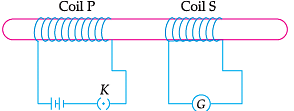
Q. State the rule which helps us to know direction of induced current:

| 1 Crore+ students have signed up on EduRev. Have you? Download the App |
In the given diagram, two coils of insulated copper wire are wound over a nonconducting cylinder as shown. Coil P has a larger number of turns. Answer the questions:
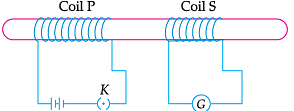
Q. When key K is opened or closed, which of the statement is false:

In the given diagram, two coils of insulated copper wire are wound over a nonconducting cylinder as shown. Coil P has a larger number of turns. Answer the questions:
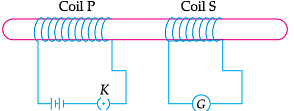
Q. Fleming's right hand rule explains:
In the given diagram, two coils of insulated copper wire are wound over a nonconducting cylinder as shown. Coil P has a larger number of turns. Answer the questions:
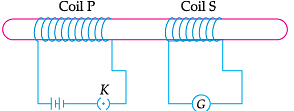
Q. In electromagnetic induction, current is induced in another conductor,
Answer the question on the basis of your understanding of the following paragraph and the related studied concepts.
Renewable energy sources such as wind energy are vital for the Indian economy, not only from the point of view of supply, but also from the perspective of environmental and social benefits. India is the world’s fifth largest wind-power producer and the largest windmill facilities in India are installed in Tamil Nadu. Muppandal is a small village of Tamil Nadu and one of the most important sites of wind-farm in the state. It uses wind from the Arabian Sea to produce renewable energy. The suitability of Muppandal as a site for
wind farms stem from its geographical location as it has access to the seasonal monsoon winds.
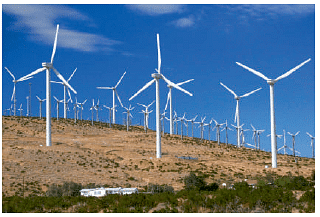
The Electrical generators used on wind turbines in sites like Muppandal, produce an output AC of 240 V and a frequency of 50 Hz even when the wind speed is fluctuating. A transformer may be required to increase or decrease the voltage so it is compatible with the end usage, distribution or transmission voltage, depending on the type of interconnection.
Q. The output frequency of a wind turbine is 50 Hz. Which of the following does not explain this statement?
Answer the question on the basis of your understanding of the following paragraph and the related studied concepts.
Renewable energy sources such as wind energy are vital for the Indian economy, not only from the point of view of supply, but also from the perspective of environmental and social benefits. India is the world’s fifth largest wind-power producer and the largest windmill facilities in India are installed in Tamil Nadu. Muppandal is a small village of Tamil Nadu and one of the most important sites of wind-farm in the state. It uses wind from the Arabian Sea to produce renewable energy. The suitability of Muppandal as a site for
wind farms stem from its geographical location as it has access to the seasonal monsoon winds.
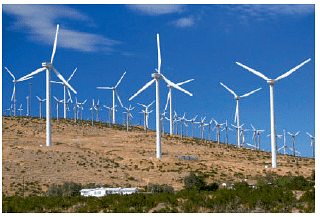
The Electrical generators used on wind turbines in sites like Muppandal, produce an output AC of 240 V and a frequency of 50 Hz even when the wind speed is fluctuating. A transformer may be required to increase or decrease the voltage so it is compatible with the end usage, distribution or transmission voltage, depending on the type of interconnection.
Q. Which device produces the electric current?
Answer the question on the basis of your understanding of the following paragraph and the related studied concepts.
Renewable energy sources such as wind energy are vital for the Indian economy, not only from the point of view of supply, but also from the perspective of environmental and social benefits. India is the world’s fifth largest wind-power producer and the largest windmill facilities in India are installed in Tamil Nadu. Muppandal is a small village of Tamil Nadu and one of the most important sites of wind-farm in the state. It uses wind from the Arabian Sea to produce renewable energy. The suitability of Muppandal as a site for
wind farms stem from its geographical location as it has access to the seasonal monsoon winds.
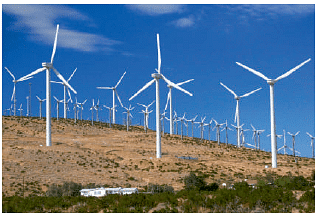
The Electrical generators used on wind turbines in sites like Muppandal, produce an output AC of 240 V and a frequency of 50 Hz even when the wind speed is fluctuating. A transformer may be required to increase or decrease the voltage so it is compatible with the end usage, distribution or transmission voltage, depending on the type of interconnection.
Q. Which of the following device does not work on the principle of electromagnetic induction:
Answer the question on the basis of your understanding of the following paragraph and the related studied concepts.
Renewable energy sources such as wind energy are vital for the Indian economy, not only from the point of view of supply, but also from the perspective of environmental and social benefits. India is the world’s fifth largest wind-power producer and the largest windmill facilities in India are installed in Tamil Nadu. Muppandal is a small village of Tamil Nadu and one of the most important sites of wind-farm in the state. It uses wind from the Arabian Sea to produce renewable energy. The suitability of Muppandal as a site for
wind farms stem from its geographical location as it has access to the seasonal monsoon winds.
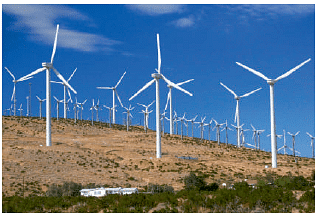
The Electrical generators used on wind turbines in sites like Muppandal, produce an output AC of 240 V and a frequency of 50 Hz even when the wind speed is fluctuating. A transformer may be required to increase or decrease the voltage so it is compatible with the end usage, distribution or transmission voltage, depending on the type of interconnection.
Q. Fleming’s left hand and Right hand rules are used in
Answer the question on the basis of your understanding of the following paragraph and the related studied concepts.
Renewable energy sources such as wind energy are vital for the Indian economy, not only from the point of view of supply, but also from the perspective of environmental and social benefits. India is the world’s fifth largest wind-power producer and the largest windmill facilities in India are installed in Tamil Nadu. Muppandal is a small village of Tamil Nadu and one of the most important sites of wind-farm in the state. It uses wind from the Arabian Sea to produce renewable energy. The suitability of Muppandal as a site for
wind farms stem from its geographical location as it has access to the seasonal monsoon winds.
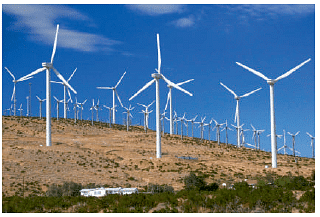
The Electrical generators used on wind turbines in sites like Muppandal, produce an output AC of 240 V and a frequency of 50 Hz even when the wind speed is fluctuating. A transformer may be required to increase or decrease the voltage so it is compatible with the end usage, distribution or transmission voltage, depending on the type of interconnection.
Q. Which device is used to increase the AC voltage to make it compatible with the end user?

















